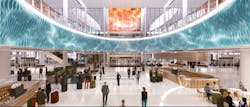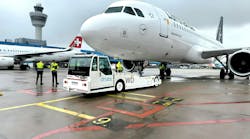The Houston Airport System is soaring to new heights with its International Terminal Redevelopment Program (ITRP) at George Bush Intercontinental Airport (IAH), a project designed to meet the increasing demand for international air travel. The ITRP is set to redefine the passenger experience and elevate the airport's status as a key international gateway.
A Surging Wave of International Traffic
The foundation for the ITRP was laid when the Houston Airport System recognized the surge in international travel, primarily from 2013 onward. This rapid growth was facilitated by the introduction of multiple international carriers. As the airport quickly approached its capacity limits, it became clear it was time for a transformative project to accommodate and enhance the passenger experience.
Houstin Airports Director Mario Diaz explains, "We started to grow phenomenally fast beginning in about 2013 when we brought in Air China, and then we followed up with Turkish Airlines, that then led to Scandinavian Air services, we brought in Korean Air, then there was EVA Air that came in. So many new international carriers came in that we really understood we were running out of space rapidly."
To accommodate this expansion, the Houston Airport System recognized the need for additional gates, specifically wide-body gates. While initially targeting 13 new gates, the project aimed to balance affordability with increased capacity.
Three Key Elements of ITRP:
The International Terminal Redevelopment Program is comprised of three critical elements:
- Renovating Terminal D: The existing Terminal D is undergoing a comprehensive refurbishment, including updates to finishes, lighting, ceilings, walls, furniture, and bathrooms. The terminal will also host new lounges, state-of-the-art international lounges, and facilities for food and beverage, retail, and news. "ITRP consists basically of three elements. Number one, it consists of the existing terminal D and completely re-lifeing and refurbishing it,” Diaz said.
- Expansion with a New D West Pier: A significant component of the project is expanding the airport's gate capacity with a new D West Pier. The new structure seamlessly connects with the renovated Terminal D, creating an extended gate concourse.
- Processor Building: The third component introduces a modern processor building designed by HOK. This building will serve as a hub for checking in passengers and conducting security screenings before they proceed to their gate concourses, either to the north (Terminal D) or south (United's Terminal E).
“One of the real problems that we're having with this international terminal today is that we don't have sufficient curbs to get the cars off of the roads to allow for proper circulation,” Diaz said. “Well, when this terminal opens, the processor opens, at the end of next year, we will be able to take 3,500 vehicles off of the roadways in any particular peak hour. That should provide for smooth operations all the way around.”
A Collaborative Design Effort by Fentress Architects
"We were tasked with doing a concept design of the entire international terminal complex. The goal was to create a roadmap for creating a cohesive experience for the passenger, from the curbside all the way through to the gate," said Thomas Theobald, Principal at Fentress Architects. This vision aimed to provide a consistent design language throughout the terminal complex.
Designing for Passenger Comfort
The design of the new D West Pier was driven by the need to simplify and clarify passenger flows for both domestic and international travelers. It addressed not only the functional aspects but also the passenger experience. The West Wall, for instance, “…is a specifically designed wall to provide protection against the western sun for the majority of the day, with the clerestory that runs down the length of the concourse to bring in a filtered daylight, kind of like the dappled trees down into the concourse. So, there's plenty of natural daylight, but it's in a controlled manner," explained Theobald.
Creating a Cohesive Experience
A key objective of the design was to create a cohesive and unified building experience for passengers. This was achieved through a carefully planned color palette, finishes, and patterns that extend from the curbside to the gate and from gate to international arrivals.
"The airport's goal was to have that all feel as if it was one hand controlled and it's one building that you go through and not a series of buildings that you process through," Theobald emphasized.
Outstanding Features of the Project
- Canopy Over Roadways: A lightweight curved canopy structure over the roadways that offers protection from weather, creating a welcoming entry for passengers.
- Oculus and LED Wall: An oculus that allows natural light to penetrate two levels down into the baggage store and a 200-foot-long, seven-foot-high LED wall that showcases the best attributes of Houston.
- West Wall: A dramatic wall in the new D West Pier that strategically manipulates natural light to provide an inviting atmosphere for passengers.
- Copper Ceiling: A striking copper ceiling that enhances the visual appeal of the airport's design.
Overcoming Substantial Challenges
The most significant challenge the project encountered was the need to renovate and expand in a confined, operating terminal space. Key challenges included dealing with existing utilities, managing vehicle traffic, ensuring passenger service during construction, and the necessity to replace certain structural elements due to unforeseen conditions.
Diaz emphasized that meticulous planning and adaptability were paramount to maintaining schedule and budget.
“In the process of renovating our airport, we faced a series of unexpected challenges, from height limitations imposed by the people mover system guardrail to dealing with underground infrastructure like tunnels and utilities,” he said. “We had to straddle an uncovered train box with steel and concrete supports, lift massive structures into place at night to connect different airport buildings, and even temporarily shut down our vintage Mickey Mouse train system, wondering if it would still function when brought back online. Operating within a confined and constrained space presented unique risks and obstacles."
Diaz stressed the significance of tackling traffic and congestion problems at the airport. The airport conducted thorough studies and developed detailed roadway models to comprehend the issues. In the planning phase, they recognized a notable issue during peak times: traffic congestion resulting from vehicles going to departures and arrivals. They understood that the crucial factor for success was redirecting departing and arriving vehicles away from the roadways and onto designated curbside areas.
“Our redesigned curbs will feature 11 departure lanes for travelers leaving the airport and eight arrival lanes for those entering, ensuring efficient traffic management and smooth circulation on the roadways,” he said.
Advice for Airports Undergoing Similar Projects
Drawing from the experience of the ITRP, Diaz provided recommendations for airports embarking on similar transformative journeys:
- Consider Greenfield Options:
“Whenever possible, avoid large-scale renovations by exploring greenfield alternatives. This minimizes the complexity of renovating an existing facility.”
- Comprehensive Project Definition Manual:
“Develop a detailed project definition manual that leaves no element unassessed. Consider every system, structure, and potential renovation, thus reducing the risk of unforeseen issues.”
- Early Engagement of Construction Management:
“Involve constructability experts from the early stages to model and address logistical challenges related to construction traffic. Develop a strategy for segregating passenger and construction traffic to maintain a satisfactory passenger experience.”
Paving the Way for Growth
The successful completion of the International Terminal Redevelopment Program positions Houston Airport to return to air service development. Diaz said the airport is now in a prime position to engage with new airlines, expand the roster of destinations, and welcome more travelers to this dynamic and well-equipped international gateway.
"What it allows for us to do now is to return to air service development... We're going to be back into growth mode over the next year bringing in more airlines, the airlines that we want to continue expanding, the destinations from which you can get to Houston,” he said.
Diaz said the conversion of D Terminal to a D Gate Concourse will be completed within the next month, with all aspects finished by the end of November of the current year. The D West Pier is expected to be substantially completed by December of the current year, with plans to open it for passenger operations in January or February of the following year. The Processor Building will be substantially completed by the end of the following year and fully operational by 2025. The new processor building that will connect Terminal D and Terminal E is expected to be finished by the end of the following year.

